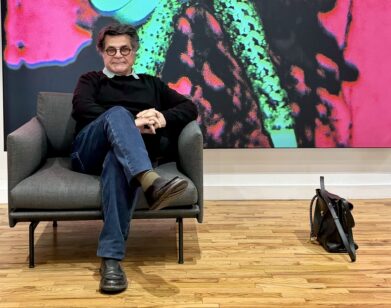John Lithgow and Alfred Molina’s Enduring Love

ABOVE: ALFRED MOLINA (LEFT) AND JOHN LITHGOW IN LOVE IS STRANGE.
Love is Strange is a poignant documentation of love: between friends, family, and, most of all, spouses. We meet George (Alfred Molina) and Ben (John Lithgow) on the morning of their wedding day. The two men have been together for 39 years. George is an English music teacher at a Catholic school; Ben a painter from the Midwest. Immediately after their marriage, George is fired from his job and the couple is forced to sell their apartment. Homeless and short on funds, they ask their friends and family for help. Ben ends up sharing a bunkbed in his 15-year-old grandnephew’s room, much to the chagrin of the grandnephew and his mother, a self-centered novelist played by Marisa Tomei. George sleeps on the sofa of his young(ish) neighbors: two gay cops with an active social life. George and Ben’s separation, however, is purely physical. Throughout the film, director and co-writer Ira Sachs hints at Ben and George’s substantial shared history: friends lost, affairs forgiven, and the events they must have witnessed as gay men in New York City during the ’60s, ’70s, and ’80s. Without each other, they are lost.
The film premiered earlier this week at Sundance to glowing reviews. While Sachs’ last movie, Keep the Lights On, was a harrowing portrait of toxic intimacy, Love is Strange is a celebration. In spite of their flaws and previous transgressions, George and Ben share an unshakeable attachment: a love based in affection and understanding that can never be replaced.
EMMA BROWN: Did you ever switch roles during the rehearsal process?
ALFRED MOLINA: No, we never did that. We talked a lot about—actually, we didn’t talk a great deal, we giggled our way through most of it. But we’re old friends and there’s such an understanding and an appreciation. I’m also a big fan of John Lithgow, so part of me was going, “I love it when John does that,” but there was another part of me going, “Oh my god, it’s John Lithgow!” We enjoyed each other in a creative way, but actually switching things, we never tried that. I think that’s usually a result of when you’re doing something that might be problematic—might be a little difficult to uncover. I’ve done it once in a stage production; we came in for two days and, just as an experiment, the director had us reading each other’s roles. You hear another voice interpreting a line that maybe you were having trouble with. It can be very helpful. But we weren’t really in the kind of situation where that was necessary.
JOHN LITHGOW: You asked whether we did it in the rehearsal process, but this film did not have a rehearsal process. Ira works in a very unique way. I was working in Calgary; Fred was living in Los Angeles. Ira traveled first to L.A. and then to Calgary and he spent two days one on one with me, one on one with Fred, reading through the script. Talking in great detail about the script.
MOLINA: He did that with all the lead actors.
LITHGOW: He didn’t want us to read our scenes together; he didn’t want us to rehearse. Even when we were shooting, he didn’t want us to carefully calculate anything beyond where you’re going to stand. He wanted us to discover it in the process of shooting. I’ve worked with a few directors who did that just because they didn’t know what else to do. But in Ira’s case, there was method in his madness. He did this exactly the way he wanted, and I think that the real truth of the performances that you see in this film are a genuine result of that. I have to give him tremendous credit, because it’s not the way that I usually work at all. I like to rehearse and rehearse and have everything exactly calculated before we start shooting—probably to a fault.
BROWN: A word that people have been using to describe this film—and really all of Ira’s films—is “intimate.”
LITHGOW: He likes to cut very close to the bone emotionally. The wonderful thing about this film is the crises in this film, apart from the big crisis about Fred’s character being fired because he’s had a gay marriage—that’s an alarming thing to have happen— but all the other crises in the film are the domestic, trifling little crises of life that any relationship endures. It’s a film that’s pitched very low, and yet you just feel the emotions of the characters. It’s a beautifully written script; it’s what sold us both on the project.
MOLINA: Yeah. There was no moment where we were saying, “The scene’s okay, but it needs a bit of this.” It was all there. Whenever you talk about a director’s style being restrained, there’s always a kind of implication that it lacks fire or it lacks emotional tension. But with Ira, it’s that very thing—that restraint, the big emotional thing happening on the edge of the frame, or even slightly in the background—that gives it that emotional punch. The long, fixed camera frame on young Joey [Ben’s grandnewphew] as he’s going down the stairs. You see all the traffic going past the window and he fills up and just releases that emotion. And then he leaves, and the camera stays on that frame as if it, somehow, might be filled by another character. Of course the truth is we fill it—the audience fills that frame. It’s heartfelt directing. Restraint always suggests something cool, something detached, but this is far from it.
LITHGOW: He’s very good at letting the audience do the work.
MOLINA: And he does it time and time again.
BROWN: Were you familiar with Ira’s past work when you read the script?
MOLINA: I wasn’t.
LITHGOW: Nor was I. I had accepted it before I’d seen his films.
MOLINA: Me too.
LITHGOW: When he took that trip to Calgary, he brought two of his films with him.
MOLINA: [laughs] I must admit, he did the same for me in L.A. He gave me a couple of DVDs: Keep the Lights On (2012) and Forty Shades of Blue (2005), which I watched first and loved. But Keep the Lights On—these are dark stories and as I was watching Keep the Lights On, I do remember thinking, “I dunno if I’m up for this … Wow, I’ve never acted like this before.” I was looking at it from a rather subjective point of view, but what you could still see in those movies is Ira’s class as a director. The way he likes to let you, the audience, do the work. It’s such a generous thing for a director to do; a lot of directors want you to see their directing, they want the audience to appreciate what they’ve done.
LITHGOW: He doesn’t want them to think about the direction. He wants to disappear. And it happens.
BROWN: How did the two of you first meet?
LITHGOW: We met on a red carpet for the Tony Awards broadcast in the early ’90s.
MOLINA: ’94 or something like that.
LITHGOW: Then we found that we had a couple of good friends in common. We had a meal together in L.A. A dear friend of ours passed away—had a very painful death—and both of us visited her in hospital. That’s when we go to know each other.
MOLINA: We spent days in St. Vincent’s with John Slattery.
LITHGOW: Slattery was there. Pattie Clarkson. That’s when I discovered what a big heart Alfred had. Beyond that, I had visited him backstage a couple of times and I used to get my hair cut in the dressing room of Fiddler on the Roof when he was doing Tevye. I was in a different production—Dirty Rotten Scoundrels—and we would hang out. We would be in adjoining barber chairs. We’d forgotten about that.
MOLINA: [chuckles] That’s right. Our hair guy, Joe, had done John’s hair for years and years, so John would come to him. I’d forgotten that.
LITHGOW: But we just knew this was going to work like a dream. Ira had so beautifully cast it. I’m so like this character Ben—I always wanted to be a painter, for one thing. I do paint. I’m also, like most artists I know, self-absorbed and abstracted and very unrealistic. I don’t deal with the nuts and bolts of life. Fred’s feet are much more firmly planted on the ground. So many of our own characteristics came into play. Didn’t you feel?
MOLINA: Very much so.
LITHGOW: We were playing characters which were just that far removed from ourselves.
MOLINA: I had to admit eventually that George reminded me very much—not of other gay men that I know—but of myself. He is, in a sense, the gay version of me. He has the same concerns for a certain kind of order, not letting things get out of control. A certain fear of letting things just happen. Whereas Ben, there’s a wonderful sense in Ben of kind of going, “Eh. What the hell. Let the cards fall where they may. Life is a game.” For George, life is not a game. Life is far too scary. I found myself kind of going, “Yeah, that’s me.” And I think that’s why we were so happy in these roles.
LITHGOW: I can’t get used to the fact that I’m 68 years old. I still feel like a youngster. I am playing a part even older than 68—71 years old. It’s kind of startling to see myself in a movie and realize, “Yup. That’s exactly what I look like.” And it’s so much like my father. I honestly feel like I’m just watching my father. But the way that I just described myself is exactly how I thought of my dad. There’s one scene where we’re dealing with the real estate woman, and George is concentrating, and I’m [looks around absent-mindedly].
MOLINA: You get it completely wrong and George just gives you a look like, “Have you been listening to anything?” Which is so totally like me. It was a lucky. It was fortuitous. And we, if I may be so bold, as individuals had the sense to recognize it and use it.
LITHGOW: We knew how lucky we were on this one. We knew this was going to be one of our greatest roles.
BROWN: We meet your characters after they’ve been together for 39 years. Did you create a backstory for them—where and when they met, etc.?
LITHGOW: Oh, yeah we talked through all of that.
MOLINA: We talked a lot about that.
LITHGOW: I grew up in Ohio. I went to the Cleveland Museum Institute of Art—no, we changed our minds, I went to the Pennsylvania Academy of Fine Arts in Philadelphia. I worked in a gallery. We had our backstory down.
MOLINA: My character immigrated to New York at a very young age. His parents were working-class immigrants. He was the first kid in his family to go to college. We had all that worked out.
For more from Sundance 2014, click here.






